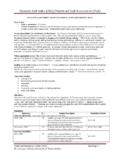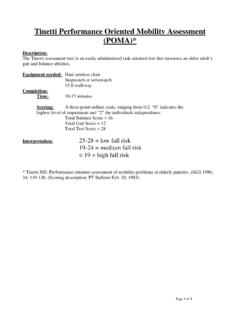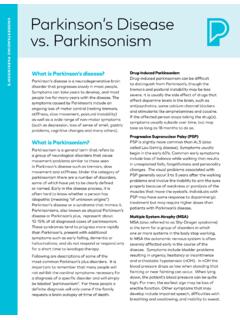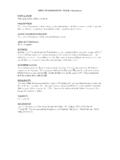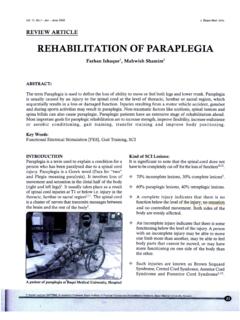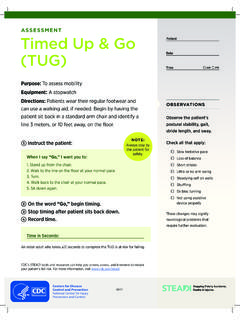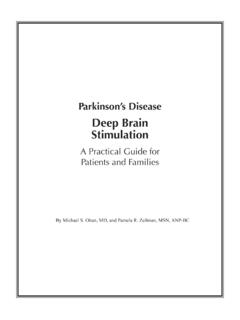Transcription of Function in Sitting Test (FIST) - POGOe
1 1 Function in Sitting Test (FIST) Training and Instruction Manual [Version ; 5/20/11] Developed & created by Sharon L. Gorman, PT, DPTSc, GCS Development and pilot testing of the FIST was funded in part by a generous grant from the California Physical Therapy Fund (#05-01)2 Function In Sitting Test (FIST) Training & Instruction Manual Table of Contents 1. Overview of FIST 3 2. Disclaimer 5 3. General FIST Instructions and Set-Up 6 4. FIST Scoring Instructions 9 5. Individual FIST Item Descriptions and Instructions 10 6. References 13 7. FIST Documentation Template (for patient documentation) 14 3 FIST Overview Purpose The Function in Sitting Test, or FIST, is a 14 item, performance-based, clinical examination of Sitting balance.
2 The FIST was designed to be administered at the hospital bedside by a physical therapist or other health care provider. It should take approximately five to ten minutes to administer. This may vary depending on the need to reposition the patient and the patient s needs for redirection or rest breaks. Patients are asked to perform basic, everyday activities in a seated position with an examiner scoring their performance using a 0-4 point ordinal scale. For ease of scoring, the scoring scale is the same for each test item. A template Function In Sitting Test Scores patient documentation sheet, where FIST scores can be recorded over time, is included in this manual for use in your clinic/facility. The purpose of the FIST is to quantify patient performance for specific functional Sitting tasks. The FIST can be used to track changes in Sitting balance over time.
3 The FIST bridges the gaps between simple observations about Sitting balance/trunk control and balance measures more heavily weighted towards standing balance or gait ability. Other Sitting balance measures or clinical scales have little documented statistical characteristics or validation of their psychometric The majority of current valid and reliable balance tests or outcome scales do not focus solely on Sitting balance and have limited sensitivity to detect smaller changes needed to justify continued No widely accepted or standardized measurement of seated Function existed when the FIST was under The FIST incorporates a variety of steady state, proactive, and reactive postural control conditions, rather than heavy reliance on proactive, motor system activation assessment, which may help clinicians better describe and quantify Sitting balance abilities.
4 4 Who may benefit from testing with the FIST? Patients with known or suspected Sitting balance deficits who cannot tolerate balance tests involving standing or gait tasks may benefit from testing with the FIST. Patients who experience problems because they are too low functioning for some tests and their progress isn t adequately reflected with an increased score ( , floor effect) on other balance measures may be appropriate for testing with the FIST. Patients with problems related to impulsivity or safety while in seated positions may benefit from the FIST, as these are components of the scoring criteria. Patients whose treatment programs are working on speed, safety, and motor control while seated may benefit from the FIST, as results may determine specific interventions to address the patient s problems or develop accurate hypotheses about the nature of the patient s balance dysfunction.
5 Who may not benefit from testing with the FIST? The FIST may be too simple, inadequate, or not sensitive enough to provide useful information for patients who do not have a problem moving in Sitting or who can tolerate standing or walking. This test has an upper scoring limit where patients who can successfully perform higher level activities, such as standing, walking, and other activities of daily living may achieve the maximum score quite easily ( , ceiling effect). Additionally, patients who are not medically stable to tolerate Sitting for the time required to complete the FIST or patients whose medical condition(s) do not allow for the movements required to complete the test items ( , forward reach with hip flexion greater than 90 , bilateral lower extremity weight bearing in seated position) will not be suitable for testing using the FIST.
6 FIST Creation The FIST was created as a dissertation project by Sharon Gorman, PT, DPTSc, GCS at the UCSF/SFSU Doctor of Physical Therapy Science (DPTSc) program in an effort to help clinicians working with lower level patients who could not successfully perform other existing balance measures without great The FIST was created as a clinical measure using an ordinal scale to describe 5 patient s abilities. The items and scoring on the FIST were created and selected using survey results from clinicians, physical therapists specializing in test creation/validation and/or balance, and existing measures of balance and trunk control. A validation study of the FIST was conducted in persons with Sitting balance deficits after acute stroke to select the final set of test items included on this version of the Internal consistency and reliability of the test items was found to be high (Cronbach s alpha = , person separation index = ).
7 10 Additional reliability and validity studies on the FIST are currently underway. Should your facility be interested in serving as a data collection center on current FIST studies, please contact Dr. Gorman for more details and to discuss research collaboration. Online Training Available Please visit our website at to view, complete, and access our online training module. It contains much of the same information as this manual, but also has photos and video clip examples of patients performing FIST items at a variety of scoring levels and an online quiz to assess learning. Disclaimer The Function in Sitting Test (FIST) was created to allow healthcare providers to better describe and document patient/client abilities to move and perform functional tasks in a seated position. Administration of the FIST was intended for persons who do not have any contraindications to Sitting or moving in the prescribed manner for the individual test items.
8 Determination of a patient s ability to safely perform the FIST lies solely with the healthcare provider administering the FIST. Additionally, as a test of balance in a seated position, it is the healthcare provider s responsibility to guard and supervise the patient/client at all times during the administration of the FIST to prevent falls or other unwanted or unexpected outcomes. 6 General Instructions and Patient Set-Up Items needed for test administration: Step stool or riser (for foot positioning, dependent on patient height) Stopwatch or watch with second hand, for timing Tape measure Small, light weight object (can use small, retractable tape measure or stopwatch for this) FIST Scoring sheet or directions from this manual Standard Patient Position: This position should be maintained throughout the test.
9 The examiner should realign the patient as needed before each test item to ensure that the patient starts in this standard position. Patient seated at edge of standard hospital bed (no overlay or specialized air mattresses), with bed flat of femur length supported by mattress while Sitting Hips and knees flexed to 90 Feet flat in support on the floor (or on a step or stool, as needed) to ensure proper hip and knee position Thighs should be positioned in neutral hip abduction/adduction and hip internal/external rotation (or as close as the patient s hip range of motion will allow) Hands in lap, unless needed for balance support (see scoring if subject uses upper extremities or hands for support) 7 Lateral view Anterior view Standard Examiner Position.
10 The therapist should be positioned to guard the patient at all times to both prevent falls and to provide any assistance with the tasks as may be required. The examiner may be positioned either to the side of the patient or in front of the patient, or both, during the test. The primary goal of the examiner s position should be to ensure patient safety and to assist as needed for scoring purposes. Administration of the FIST: Read all directions, described below in quotation marks, to the patient. Additional information is included to help the therapist set up or score the test. All of the directions, including the overall test description and each individual FIST item directions, use simple English directions at no higher than a 6th grade level. The FIST test items should be delivered in the order described in this manual or on the score sheet, with the exception of the 3 nudge items which are randomly interspersed throughout the testing.




